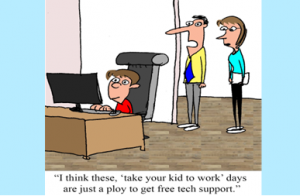February 2023 Newsletter
15 Minutes That Demonstrated Workplace Change Over The Last 3 Years Is Nothing Compared To What Is Coming
Chris and I travelled to Phoenix in January 2023 to meet with other IT business owners who work with the TruMethods methodology. One of the outcomes of this event was a chance encounter with technology that is surely going to change the way we live in the future.....
In the last 3 years the workplace has been shaken up more than at any time since the industrial revolution. However, I predict (says Chris), the current impact of labour shortages are here to stay, and that, combined with fast maturing technology, will have even greater impact on our businesses and lives. A recent car journey left me with a clear decision: get onboard or be left standing at the curb side.
After dinner one night, with a bunch of other IT business owners in the US city of Phoenix, we needed a ride back to the hotel. It turns out, Phoenix is one of the only places in the world you can hail a fully driverless cab. Being a bunch of tech enthusiasts, one of the groups ordered us a Waymo.
As the car silently pulled up to the kerb, half of our group were nervously excited to give it a try. The other half refused to get in. I was in the former group, and I will admit I screamed a little as the doors clunked locked, the steering wheel started to turn, and the car accelerated off into the traffic. already use them.
But, after 10 mins, we had all gotten accustomed to it as we talked about … well … the future.
Ironically, we had just spent the day at a tech conference where we discussed how automation will change the way our workplace's function. It has all seemed difficult and expensive back at the venue. Now, the devastating realisation hit me - this is automation in action in a way that, until this moment for me, was only a theoretical possibility.
Only hours earlier we had literally been debating how hard it might be to fully automate an invoicing process or onboarding a new employee into a company (including setting them up in HR systems, ordering and configuring their new PC). And now there I was gliding around a left turn across oncoming traffic by a robot in a car's body.
Instantly my comprehension of what will be possible opened up (which was represented in that moment by my jaw hanging opening but no words managing to form).
Ok - I am not suggesting that we all contact our HR depts to work out how we go about replacing our staff with robots. But I am saying that we are about to embark on a period of unprecedented change in our organisations. The last few pandemic ridden years have changed the way we work more dramatically since the industrial revolution.
The global shortage of workers combined with maturity of technology such as artificial intelligence (e.g. ChatGPT) and automation technology creates an inflection point which will drive even more radical change in the next 5 years.
There will be winners and losers - those that can embrace the possibilities and execute effectively will come out with a distinct competitive advantage.
Best get back to work before I lose my job to a robot
🙂
ChatGPT Re-writes The Above Article
I asked ChatGPT to write a version. I asked it to make it sound more dramatic. It did OK!
The workplace as we know it has undergone a seismic shift in the past three years, with changes more profound than any since the industrial revolution. But the tremors felt thus far are merely a forewarning of the earthquakes to come. The convergence of the global labour shortage and fast-maturing technology, including artificial intelligence and automation, has created a tipping point that is set to rock the very foundations of our organizations.
Last week, while on a dinner outing with a group of IT business owners in Phoenix, I had the opportunity to experience the future of work first-hand. Phoenix, as it turns out, is one of the few cities in the world where you can hail a fully driverless cab. One of our tech-savvy companions ordered us a Waymo, and we stepped into the unknown.
As the car silently pulled up to the curb, some of us were filled with nervous excitement, while others were hesitant to trust the technology. I was among the former, and I must admit, I let out a scream as the doors clunked shut and the car started to move on its own. But just ten minutes later, we were all marvelling at the possibilities of this revolutionary technology as we discussed the future of work.
Only hours earlier, we had been locked in debate at a tech conference about the difficulties and costs of automating various workplace processes, from invoicing to employee onboarding. But now, as I sat in the driverless cab, I was given a glimpse of what was actually possible. My understanding of what we could achieve as an industry expanded in that moment, represented by my jaw dropping in awe.
I am not suggesting that we should start looking to replace our staff with robots just yet. However, I am saying that we are on the cusp of a period of unprecedented change in our organizations, and those who embrace the possibilities and execute effectively will have a competitive advantage. The past few pandemic-ridden years have already altered the landscape of work more dramatically than any time since the industrial revolution. And this, my friends, is only the beginning.
So, as I step out of the driverless cab and return to the world of work, I am filled with a sense of urgency. The time to act is now. The future is here, and those who are not ready risk being left behind. So, let us embrace the change, and get to work, before the robots do.
Movers and Shakers at Vermont
Since November 2021 the Vermont team has grown by 6 new team members, and there has been a number of changes in job roles and responsibilities. With that in mind we thought it would be good to update you on those changes.
Sam Wildridge is transitioning from a Technology Success Manager (TSM) to our virtual CIO, and managing the rest of the Proactive team. He will be taking over a number of Chris’s clients, but still working closely with Chris. Matt Stott is joining Brad Reeves as a TSM in that team (and leaving support behind).
Ian King has joined Angus in the support desk and as Ian is an experienced engineer has picked things up really fast.
Nigel King (no relation to Ian) has taken on a role of designing solutions and investigating future technologies that our clients can use to their advantage.
In November 22, Mike Cripps joined Adam Wood and Adam Reeves in the Professional Services team, working on the installation of systems. The team is headed up by Lawrence Purser, who will also manage the projects.
Last September Liz Mead joined Dave Overton in the finance team, managing the procurement of equipment for our projects team. And there is Oliver, John and Chris in the commercial and marketing teams.
Close Any Deal with This 3-Step Approach
It’s one thing to help a client identify a problem, but it’s another to help them solve it. You’ll need to convince clients to accept your expertise to solve their problems. Many intelligent people struggle with closing deals, so I devised the following three strategies to help anyone become a better closer.
Summarize The Underlying Need
I once went into the office of a greatly admired billionaire CEO with a colleague. He had been asked to come strategize for 90 minutes on how to identify and solve the CEO’s top leadership problems. The CEO talked about scary changes in his industry while laying out his heart about his team and their strategies. When he stopped talking, my colleague was presented with the perfect opportunity to summarize the client’s underlying need. Instead, he directly asked the CEO what he thought the next steps should be. The CEO was unamused and said, “Well, I don’t know. I was hoping you might tell me.”
My colleague should have taken a moment before responding to analyze the emotion behind what was just told to him. Once the client realizes you understand their situation, they’re more likely to listen to your plan of action.
Say What You Plan To Do
Smart people worry about putting themselves out there by offering a plan. They fear that another smart person is going to disagree with them. They worry about proposing a plan that doesn’t work. That’s why many advisors stay “safely vague” rather than offer a specific plan. But being vague doesn’t help leaders solve their biggest problems. You must have the courage to propose a plan. The key is to be as specific as possible. Break down your ideas and lay them all out. If the client has concerns about any areas, you can address them, but they’ll be happy to see the wheels are turning in your mind as you come up with solutions to their problems.
Ask If They Want Your Help
So many smart people get a gag reflex when it comes time to ask for the sale. They think selling is evil. They don’t view themselves as salespeople. And besides, if a client realizes how great a consultant is, they will ask for the sale themselves, won’t they? But business doesn’t happen that way. The client wants to know you want to help. It’s their insecurity that often holds the client back from closing themselves. That’s why you have to do it. And don’t view it as selling – view it as an offering of help. Don’t you think it’s nice to offer to help somebody accomplish something important to them?
Keep Your Customers Happy By Avoiding These 3 Selling Strategies
You’ve probably been on the receiving end of some poor sales strategies without even realizing it. For example, a salesperson said something that rubbed you the wrong way, sending you out through their doors and into the arms of a competitor. While it might have been a frustrating experience for you then, it’s much worse if you or your sales team use these tactics in your business.
You want your customers to enjoy working with you, so you and your sales team must utilize strong sales strategies. Here are three selling tactics you want to avoid at all costs.
Not Addressing The Customer’s Primary Problem: Customers rarely walk into a place of business on a whim anymore. They usually have a very specific problem they need help to solve. Fully listen to their concerns and provide a solution to their problem. Do not push your products or services down the customer’s throat if they have nothing to do with their dilemma.
Overpromising And Underdelivering: Some salespeople think the key to boosting sales numbers is to promise their customers the world, even if what they’re promising is impossible. If you fail to deliver on your promise, you’re essentially lying to your customers, which destroys their trust in your business.
Arguing With Customers: You may know your product or service better than your customers, but that doesn’t mean you should combat them if they have concerns or unrealistic expectations. Stay silent and ask questions about what they need. The second you start arguing with them, you’ve lost the sale.
How To Make A Positive Experience For Unhappy Customers. When a customer is upset with your business or team, you may think there’s no way to sway their opinion. This couldn’t be further from the truth. You have the power to please and change the views of unhappy customers. By utilizing the following strategies, you’ll know how to handle displeased customers and maybe even turn them into lifelong clients.
Listen To Them. Your customer’s complaint likely has nothing to do with you personally, but how you respond to them can make or break their lifetime value. Be empathetic and listen to what they say.
Be A Creative Problem-Solver. After you hear the concerns or complaints from your clients, ask yourself if their problem is solvable. In most cases, it is, but it will require some brainstorming. Think outside of the box and deliver exceptional service, and you’ll gain a customer for life.
Work Efficiently To Solve The Problem. When you get a complaint from a customer, don’t sit on it. They want an immediate solution or response, so take a minute to think and come up with a solution that works for everyone.




You must be logged in to post a comment.